Intro
Discover the uses and benefits of Sulfameth Trimethoprim 800 160 Mg Tablet, a potent antibiotic treating bacterial infections, including urinary tract infections, with trimethoprim and sulfamethoxazole, offering effective relief and prevention.
Sulfamethoxazole and trimethoprim, commonly known as co-trimoxazole, is a combination antibiotic used to treat various bacterial infections. The 800/160 mg tablet is a specific dosage form of this antibiotic, where 800 mg of sulfamethoxazole and 160 mg of trimethoprim are combined. This combination is effective against a wide range of bacteria, making it a versatile treatment option for different types of infections.
The importance of understanding sulfamethoxazole and trimethoprim cannot be overstated, as it is crucial for patients to be aware of the benefits and potential side effects of the medications they are taking. This knowledge enables patients to take their medications safely and effectively, minimizing the risk of adverse reactions. Moreover, with the rise of antibiotic resistance, it is essential to use antibiotics like sulfamethoxazole and trimethoprim judiciously, ensuring they remain effective against bacterial infections.
Sulfamethoxazole and trimethoprim work by inhibiting the growth of bacteria, ultimately leading to their death. Sulfamethoxazole belongs to the class of sulfonamide antibiotics, which inhibit the synthesis of folic acid in bacteria, a critical component for their growth and survival. Trimethoprim, on the other hand, is a dihydrofolate reductase inhibitor, which further disrupts the bacterial synthesis of tetrahydrofolate, an essential precursor for DNA synthesis. The combination of these two mechanisms of action makes sulfamethoxazole and trimethoprim a potent antibiotic against a broad spectrum of bacterial pathogens.
Introduction to Sulfamethoxazole and Trimethoprim
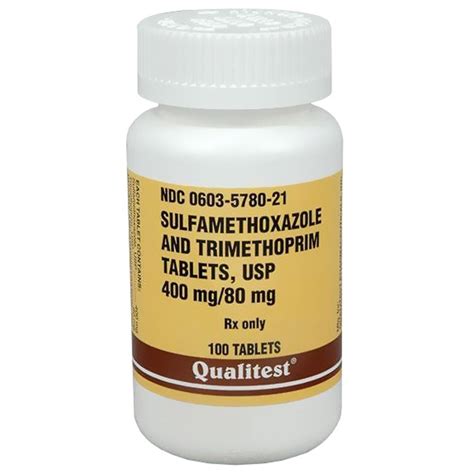
Sulfamethoxazole and trimethoprim are prescribed for the treatment of various bacterial infections, including urinary tract infections, ear infections, bronchitis, traveler's diarrhea, methicillin-resistant Staphylococcus aureus (MRSA) skin infections, and pneumocystis pneumonia (PCP) in patients with HIV/AIDS. The effectiveness of this combination antibiotic lies in its synergistic action, where the combination of sulfamethoxazole and trimethoprim is more effective than either drug alone.
Benefits of Sulfamethoxazole and Trimethoprim

The benefits of sulfamethoxazole and trimethoprim include their broad-spectrum activity against both gram-positive and gram-negative bacteria. This makes them effective against a wide range of bacterial infections. Additionally, the combination of sulfamethoxazole and trimethoprim has been shown to reduce the development of antibiotic resistance, as the two drugs target bacterial cells through different mechanisms. This dual-action approach enhances the efficacy of the treatment and minimizes the risk of the bacteria developing resistance to the antibiotic.
Working Mechanism
The working mechanism of sulfamethoxazole and trimethoprim involves the inhibition of folic acid synthesis in bacteria. Sulfamethoxazole competes with para-aminobenzoic acid (PABA) for the enzyme dihydropteroate synthase, which is necessary for the synthesis of dihydrofolate. Trimethoprim, on the other hand, inhibits the enzyme dihydrofolate reductase, which is required for the conversion of dihydrofolate to tetrahydrofolate. Tetrahydrofolate is essential for the synthesis of purines and thus for DNA synthesis and bacterial growth.Side Effects and Precautions
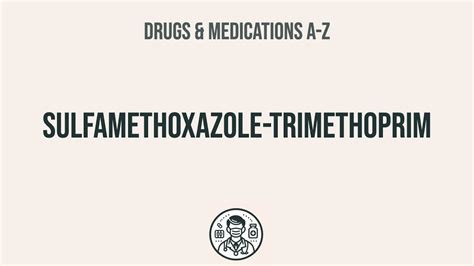
While sulfamethoxazole and trimethoprim are generally well-tolerated, they can cause side effects in some individuals. Common side effects include nausea, vomiting, diarrhea, and skin rashes. More severe but less common side effects can include severe allergic reactions, liver damage, and blood disorders. It is essential for patients to inform their healthcare provider about any pre-existing medical conditions, especially kidney or liver disease, as these may affect the dosage and administration of sulfamethoxazole and trimethoprim.
Precautions and Interactions
Patients taking sulfamethoxazole and trimethoprim should be aware of potential drug interactions. This combination antibiotic can interact with a variety of medications, including blood thinners, diabetes medications, and certain antidepressants. Additionally, patients with known allergies to sulfonamides or trimethoprim should inform their healthcare provider, as they may be at risk of an allergic reaction. Pregnant women and breastfeeding mothers should also consult their healthcare provider before taking sulfamethoxazole and trimethoprim, as the safety of the medication in these populations has not been fully established.Dosage and Administration
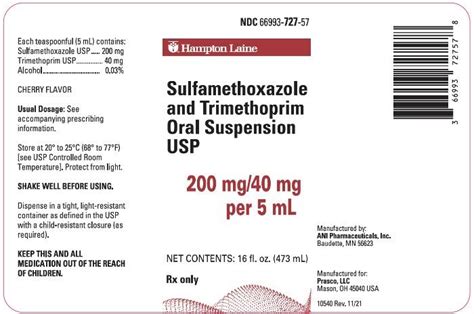
The dosage and administration of sulfamethoxazole and trimethoprim depend on the type and severity of the infection being treated. The typical adult dosage for uncomplicated urinary tract infections is 800 mg of sulfamethoxazole and 160 mg of trimethoprim taken orally every 12 hours for 10 to 14 days. For more severe infections, the dosage may be increased, and the treatment duration may be extended. It is crucial for patients to follow the dosage instructions provided by their healthcare provider and complete the full treatment course, even if symptoms improve before finishing the medication.
Steps for Taking Sulfamethoxazole and Trimethoprim
To ensure the safe and effective use of sulfamethoxazole and trimethoprim, patients should follow these steps: - Take the medication exactly as prescribed by the healthcare provider. - Complete the full treatment course, even if symptoms improve before finishing the medication. - Inform the healthcare provider about any pre-existing medical conditions or allergies. - Be aware of potential side effects and report any severe reactions to the healthcare provider. - Do not share the medication with others, as this can lead to the development of antibiotic resistance.Practical Examples and Statistical Data
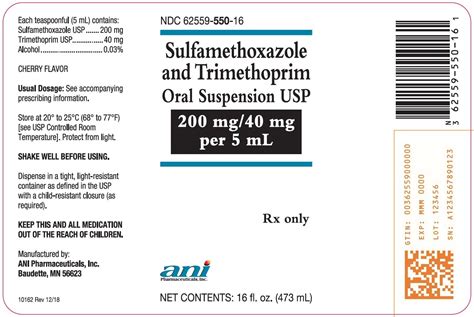
Studies have shown that sulfamethoxazole and trimethoprim are highly effective in treating urinary tract infections, with cure rates ranging from 80% to 90%. Additionally, the combination antibiotic has been shown to reduce the risk of recurrent infections in patients with a history of urinary tract infections. Statistical data also indicate that the use of sulfamethoxazole and trimethoprim can reduce the length of hospital stays and the overall cost of treatment for bacterial infections.
Benefits for Specific Patient Groups
Sulfamethoxazole and trimethoprim have been particularly beneficial for certain patient groups, including: - Patients with HIV/AIDS: The combination antibiotic is effective in preventing and treating pneumocystis pneumonia (PCP), a common opportunistic infection in individuals with weakened immune systems. - Patients with urinary tract infections: Sulfamethoxazole and trimethoprim have been shown to be effective in treating both uncomplicated and complicated urinary tract infections. - Patients with skin and soft tissue infections: The combination antibiotic has been used to treat skin and soft tissue infections, including those caused by MRSA.FAQs
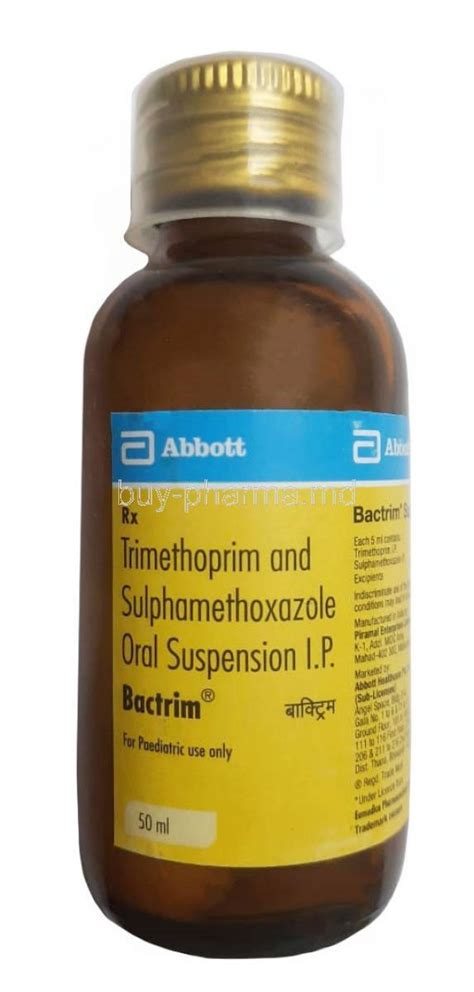
What is the typical dosage of sulfamethoxazole and trimethoprim for urinary tract infections?
+The typical adult dosage for uncomplicated urinary tract infections is 800 mg of sulfamethoxazole and 160 mg of trimethoprim taken orally every 12 hours for 10 to 14 days.
Can sulfamethoxazole and trimethoprim be used in pregnant women?
+Pregnant women should consult their healthcare provider before taking sulfamethoxazole and trimethoprim, as the safety of the medication in this population has not been fully established.
What are the common side effects of sulfamethoxazole and trimethoprim?
+Common side effects include nausea, vomiting, diarrhea, and skin rashes. More severe but less common side effects can include severe allergic reactions, liver damage, and blood disorders.
In conclusion, sulfamethoxazole and trimethoprim are a highly effective combination antibiotic used to treat a wide range of bacterial infections. The 800/160 mg tablet is a common dosage form, and patients should be aware of the benefits, potential side effects, and precautions associated with this medication. By understanding how sulfamethoxazole and trimethoprim work and following the dosage instructions provided by their healthcare provider, patients can ensure the safe and effective use of this combination antibiotic. We invite readers to share their experiences or ask questions about sulfamethoxazole and trimethoprim in the comments section below, and we encourage you to share this article with others who may benefit from this information.
